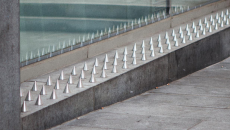
Email: stella@papersnail.co.uk
Total Article : 28
About Me:Sixth form student studying Politics, Biology and Psychology. I'm interested in a range of topics such as music, current affairs, women's issues and world politics.

London, and indeed Londoners, are frequently accused of being unfriendly. I had never given this sentiment much thought until I recently began to notice that even London’s architecture screams “go away!” From angled bus stop benches that no one can bare to perch on for more than twenty minutes, to the high pitched mosquito noise that plays outside shops to stop young people hanging around there – by far the worst example that I’ve seen has been the introduction of anti-homeless spikes across shop windows and around offices in London.
Putting spikes up like these doesn’t address the issues of inequality and poverty at all – it merely pushes them out of our immediate vision so that we don’t have to face the reality that, yes, some people are homeless. These spikes say something profound about social attitudes towards the marginalised in our society. They exemplify the common process of ‘othering’. When trying to distance ourselves from social failures, we are prompted to believe that individuals living on the street must have made a series of bad decisions which ultimately led them to destitution. This is because it is so much easier to move someone on without caring if it is their own fault they are destitute in the first place. In other words, you’re homeless - your problem, my shop front window – my problem.
Anti-homeless spikes are not the only method of situational homelessness ‘prevention’ – from momentary water sprinklers in New York, to metal park benches with solid dividers, to masses of pointed bollards under bridges, urban spaces are belligerently and unforgivingly rejecting the homeless. Situational prevention doesn’t tackle the problem of homelessness at all; it simply displaces it, moving it on to elsewhere. Destitution exists as a seperate reality. City architectures work hard to keep it outside of our field of vision. It is too miserable, too demoralising, and all too real to look at someone shivering in a park on a pile of newspapers, or sleeping in a doorway, and think of them as just like you, with parents, an education and hopes. It is easier to see them and ask the self-centered question: “How does their destitution affect me?” We try very hard at not seeing, because we do not want to see. This sentiment stretches further, to how it is commonplace for us to walk, looking straight ahead past someone begging on the street – not because we are inherently cruel, cold people, but because the acknowledgment of the existence of destitution makes us question what we can really do to help – giving two pounds here and there doesn’t seem to suffice.
The introduction of anti-homeless spikes in London is just a symptom of the disease that is the growing distinction between the haves and the have-nots. They keep destitution unseen and disinfect our public spaces, preventing any guilt for spending hundreds of pounds on new things, whilst there are people outside who can’t afford a five-pound shower at Kings Cross. I hope that eventually there will be no such thing as haves and have-nots, only people.
Image Credits: https://www.fastcoexist.com/3049178/

0 Comment:
Be the first one to comment on this article.